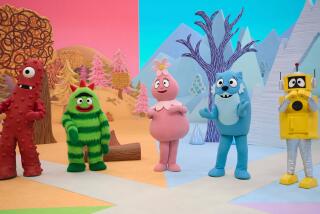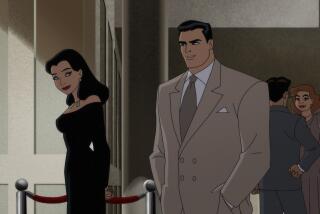Those yabba-dabba-doo-ers
As a youngster in the 1970s, Mike Henry, the executive producer and co-creator of “The Cleveland Show,” Fox’s upcoming animated spinoff of its hit “Family Guy,” would have a “Yabba-dabba-doo” time sitting on shag carpet in the living room of his childhood home watching Hanna-Barbera cartoons such as “The Flintstones,” “Scooby-Doo” and “The Jetsons.”
“It’s all I watched as far as animated stuff goes,” says Henry, who also supplies the voice of Cleveland, among other characters on the show. “I have two kids, and it’s still great to be able to watch ‘Scooby-Doo’ with them.”
Hanna-Barbera, says Henry, “laid the foundation for people being fans of animation. . . . All the people, I am sure, who have created all the current animated shows grew up watching these shows. Our shows wouldn’t be there without them kind of pioneering the medium.”
Paying tribute to these pioneers, the Paley Center for Media in Beverly Hills is currently celebrating the legacy of the late William Hanna and Joseph Barbera with “Yabba-Dabba-Doo! A 70th Anniversary Salute to Hanna-Barbera,” offering screenings of their older cartoons, such as “Magilla Gorilla” and “Jonny Quest” as well as more recent shows, such as “Johnny Bravo,” through Sept. 27. The Paley is also hosting an exhibition of art from their productions and a panel discussion at 4 p.m Saturday featuring veteran layout artist Jerry Eisenberg (“The Flintstones”) among others.
Hanna and Barbera met at MGM in the late 1930s; in 1940 they jointly directed the animated short “Puss Gets the Boots,” which was nominated for an Oscar and led to the creation of “Tom and Jerry,” about a mouse who always outwits his feline buddy. Those cartoons were nominated for more than a dozen Academy Awards, winning seven.
When the movie studios’ cartoon departments folded in the 1950s because of television, the duo founded Hanna-Barbera Productions. HB became the first company to produce animated shows specifically for the small screen. Among their first big successes was “The Huckleberry Hound Show.” They went prime time in 1960 on ABC with “The Flintstones,” their prehistoric spoof of “The Honeymooners.”
By the late 1960s, they were one of the most prolific TV animation studios. Among their successful series were “Atom Ant,” “Augie Doggie,” “Josie and the Pussycats,” “The Jetsons,” “Jonny Quest,” “Top Cat” and, of course, “Scooby-Doo.”
Eventually, Ted Turner bought the studio in 1991. With Hanna’s death in 2001, the studio was absorbed into Warner Bros. animation. Joe Barbera remained with WB animation until he died in 2006. These days, the name and studio is used to market properties based on HB classics.
Hanna-Barbera achieved financial success because of their conception of “limited animation” -- their series were more dialogue intensive than detailed animation; character designs were simplified and backgrounds and movement cycles such as walking and running could be reused.
Critics and fellow animators, though, were vocal in their distaste for this style of animation, labeling it cheap. But Van Partible, who joined HB in 1994 where he created the Cartoon Network series “Johnny Bravo,” believes limited animation received too much criticism.
“When they started out, it wasn’t feasible for TV animation to be produced, but they figured out a process,” he says.
“If you look at the designs of all the Hanna-Barbera cartoons, they are beautifully designed, but they are designed to be limited in their animation,” says Partible.
Fred Seibert, Hanna-Barbera Cartoons president from 1992 to 1997, adds that HB’s strong characters and stories more than made up for any animation deficiencies -- and, in fact, their style has influenced today’s animators: “There is a whole new generation of cartoonists who are doing the same thing on the Internet, who are making limited animation like it’s the most sophisticated thing in the world.”
Former employees such as Jerry Eisenberg, who began in layout and design at the studio in 1961, have fond memories of their time at HB.
In layout, he says, they worked six months on design and six months on development and presentation. Sometimes, Barbera and the writers would come up with new concepts. But artists would also come up with ideas.
“Once I was thinking about a hippopotamus,” Eisenberg explains. “Since I was overweight, I could relate to that. So I started making some drawings in the Hanna-Barbera style -- the character standing on two legs. I put a safari coat on him and a pith helmet. Joe kind of liked it, so he got some writers together and we began to work on it. I don’t know who came up with the name, but that was Peter Potamus.” The cartoon premiered in 1964.
Hanna, says Eisenberg, oversaw the animation, camera, and ink and paint departments. “Layout was pretty much Joe’s [Barbera] department. I learned so much from Joe. When we were in production and doing layouts, we would bring the layouts up to his office and he looked them over. He gave me a lot of good information. He had such good comedy writers, and Joe was a writer himself.”
For information on the Hanna-Barbera events, go to www .paleycenter.org.
--
More to Read
The biggest entertainment stories
Get our big stories about Hollywood, film, television, music, arts, culture and more right in your inbox as soon as they publish.
You may occasionally receive promotional content from the Los Angeles Times.











